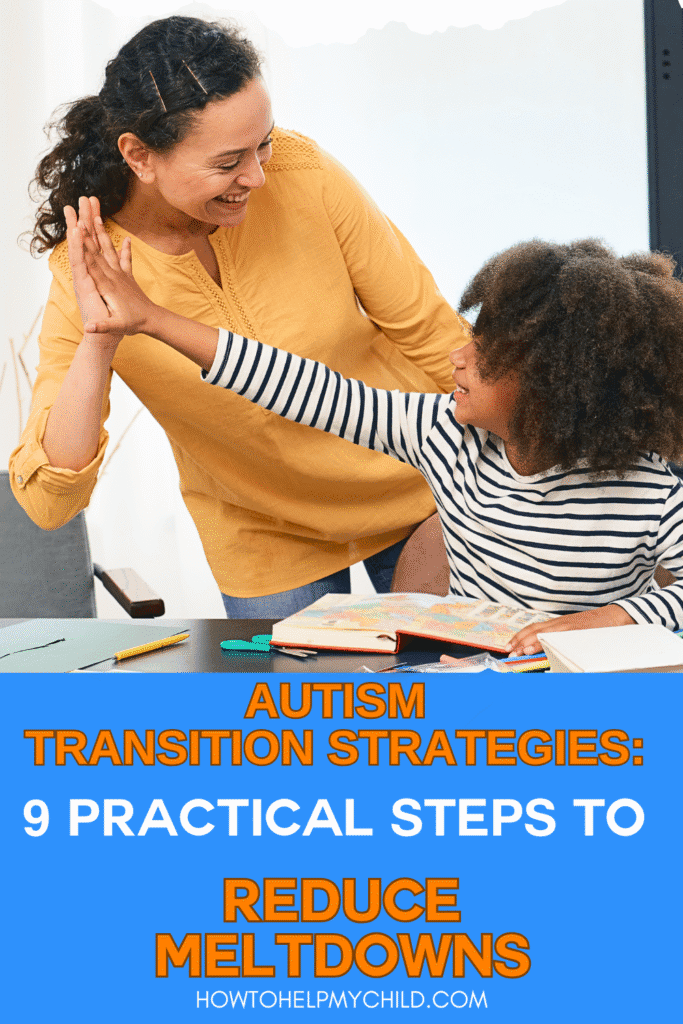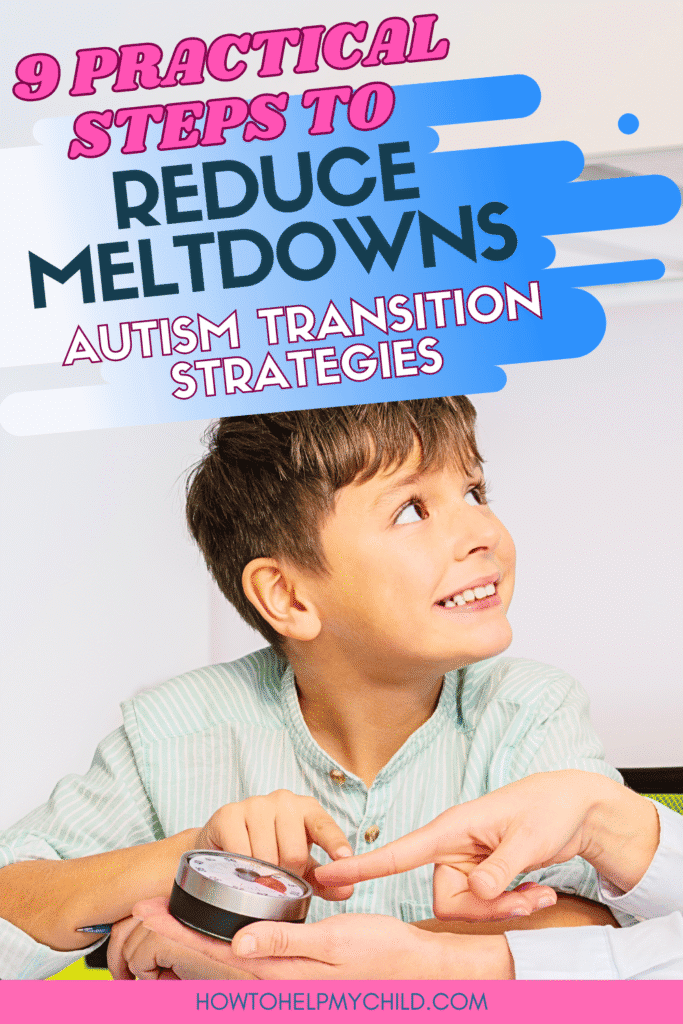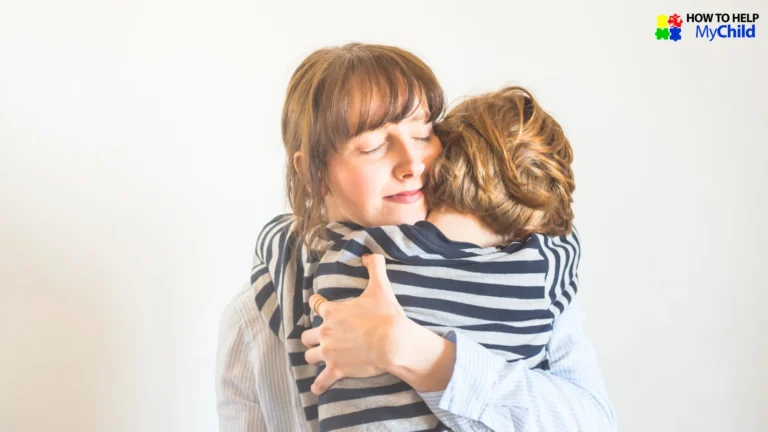Autism Transition Strategies: 9 Practical Steps to Reduce Meltdowns
Connection-based tools to make autism transitions easier and calmer for your neurodivergent child
Does your child fall apart every time it’s time to leave the house, turn off the iPad, or switch from one activity to another?
You’re not alone Mom.
And you’re not doing anything wrong.
For children with autism, ADHD, or sensory processing differences, transitions are one of the most common triggers for meltdowns.
They can feel like stepping off a cliff without a bridge.
Even small changes – like finishing snack time or getting into the car – can spark overwhelm, refusal, complete shutdown or full on meltdown mode.
Here’s what I want you to remember:
It’s not bad behavior.
It’s not defiance.
It’s a nervous system in distress.
Children with autism and ADHD often struggle with transitions because their brains crave predictability.
Their bodies feel unsafe when routines change suddenly.
That’s when meltdowns happen.
Not because they want to upset you,
but because everything inside them is screaming,
“I don’t know how to handle this!”
It’s your child’s nervous system saying: “This is too much for me right now.”
Why transitions cause so much stress for neurodivergent kids:
- Executive functioning challenges can make it hard for your child to mentally shift gears.
- Sensory sensitivities mean that unexpected changes can feel jarring or even threatening.
- Anxiety about what’s coming next can create panic, especially if routines are disrupted.
- And because many of our neurodivergent kids thrive on predictability, even small surprises can feel like the rug being pulled out from under them.
But there’s good news:
With a few gentle strategies, you can turn chaotic transitions into calmer ones – and help your child feel safer and more in control.
These 9 steps are designed to reduce transition-related meltdowns by building emotional safety, predictability, and connection.
Transitions don’t have to derail your day.
With the right tools and support, you can make transitions smoother, calmer, and more predictable – for both your child and you.
Recognizing these challenges is the first step in developing effective strategies to ease transitions and reduce meltdowns.
📺 Prefer to watch? Check out the video here:
1. Use Visual Schedules to Create Predictable Transitions

Visual schedules act like a daily roadmap for your child, using pictures, symbols, or words to outline upcoming activities.
Visuals help your child to see what’s happening now and what’s coming next.
This helps your child to control their body and enables their brain to relax.
Why Visual Schedules reduce meltdowns:
Visual Schedules remove the “unknown,” which is often the meltdown trigger. Using visuals give your child a sense of control and safety.
Use consistent visuals to reinforce routine and familiarity.
They provide predictability and structure which reduces transition-related anxiety.
The added benefit is that visual schedules promote independence as your child with autism and ADHD learns to follow the flow of the day.
Tips to make Visuals work:
- Use pictures, real photos, or icons.
- Include favorite things like snack or movement time.
- Review the schedule every morning to set expectations.
- Display it where your child can easily reference it.
💛 From a Mom in Our Community:
“We add a happy face next to the activities Tommy likes, and it helps him feel more in control.”
— Jenna, mom of Tommy, a 5-year-old with autism
2. Social Stories Help Prepare for Tricky Changes

Social stories help your child walk through the transition in their mind before it happens.
They are short, personalized narratives that explain a situation and what to expect.
Just like your neurodiverse child’s personalized story!
Social Stories help your child walk through the transition in their mind before it happens.
Why Social Stories reduce meltdowns:
Knowing what to expect lowers your child’s anxiety.
It helps them practice how they might feel, and what they can do, during the transition or challenging situation.
Social stories gently teach the appropriate responses your autistic child can use.
This reduces their anxiety by offering predictability and familiarity.
How to use Social Stories:
- Write a short story using first person language (“I may…”)
- Include what might happen, how your child can respond, and what comes after.
- Keep the language simple and the visuals relatable.
- Read it often, especially before the transition or challenging event.
💛 From a Mom in Our Community:
“Reading a social story about visiting the dentist helped my son feel more at ease during the appointment. He knew what to expect and wasn’t so afraid of the unknown.”
— Emily, mom to 7-year-old Liam with autism
3. Add Visual Cues to Support Step by Step Transitions

Visual cues are gentle prompts that clarify expectations.
They are like silent coaches – guiding your child through what to do next.
Why Visual Cues reduce meltdowns:
Transitions can overwhelm the part of your neurodiverse child’s brain that helps them plan, organize, and switch gears.
Visual Cues make it easier for your child with autism, to see what’s expected instead of trying to guess.
They set clear expectations, which reduces overwhelm and confusion your child may face.
This builds confidence and supports independence and success.
How to use Visual Cues:
- Use “First/Then” boards.
- Label drawers or baskets for cleanup.
- Pictures showing the steps in a task.
- Post visuals for common routines like bedtime or getting ready.
💡TIP
The fewer words, the better!
Visual Cues work best when they are simple and consistent.
4. Ease Into Change With Timers and Countdowns

Timers give your child a visual sense of how long an activity will last and when a change is coming.
Allowing them to shift gears gradually.
Why Timers reduce meltdowns:
Sudden change can feel like a crash for your child.
Especially when they are focused on their favorite activity.
A visual timer or countdown helps your child prepare for the switch.
Visual Timers and countdowns, build emotional regulation because they make time more concrete, which reduces resistance to transitions.
Ideas to try:
- Use visual timers like a sand timer, countdown app, or kitchen timer
- Pair the timer with a verbal countdown: “3 more minutes, then it’s time to pack up.”
- Count down with fingers for little ones
💛 From a Mom in Our Community:
“Before, turning off the iPad caused huge meltdowns. Now, we set a timer, and it’s become part of the routine with much less resistance and fewer meltdowns.”
— Sarah, mom to 9-year-old Ava with ADHD
5. Practice Transitions in Advance to Build Confidence

Rehearsing transitions when your child is calm helps build predictability and skill by making them feel less scary.
Why practicing transitions help to reduce meltdowns:
When your child practices transitions it reduces anxiety in the moment by reinforcing expectations through repetition and familiarity.
Basically, it takes the pressure off.
Your child knows what to expect and feels more capable when it’s time to do the real thing.
This is helpful if your child has sensory processing issues too.
The bonus is this repetition builds a sense of control and confidence.
How to practice:
- Role play challenging transitions with dolls or action figures.
- Use pretend play to “go to school” or “clean up.”
- Keep it short and low-stress.
- Use visual aids and countdowns.
- Reinforce successes with praise or a small reward.
💡TIP
Start small with transitions. Practice “ending playtime” before dinner, then gradually build up to bigger transitions like leaving the park.
6. Use Positive Reinforcement and Rewards to Encourage Success

Praise and encouragement can go a long way in making transitions smoother.
Catch the calm.
Praise the transition.
Celebrate small successes.
Why Rewards & Positive Reinforcement reduce meltdowns:
Applying positive direction and praise reinforces desired behaviors that you want your neurodiverse child to use.
It helps build motivation and confidence, because every child loves to be praised.
They really do want to ‘do the right thing!’
Strengthens your connection with your child as they learn, “I can do hard things, and I feel good when I do.”
Ideas to teach Positive Reinforcement:
- “I love how you moved to the next activity!”
- “You moved to bedtime without a fuss – I’m so proud of you!”
- Use tokens, visuals, or simple checklists to show progress
- Let your child choose a small reward
Remember you are rewarding the process – not the outcome!
Trying is just as important as actually achieving!
💡TIP
Focus on effort, not perfection – “You tried really hard to switch tasks!”
7. Partner with Therapists and Educators for Consistent Support

Consistency across environments is key.
Your child is more likely to succeed when home and school use the same language and strategies.
Team up with the professionals who know your child.
Why Partnering with your Child’s Therapists reduce meltdowns:
Having consistency at all places – home, school, therapy – helps your child feel safe and supported, even during tough transitions.
You may find that your therapists offer different ideas, that are expert strategies tailored to your child.
The best part of collaborating together is the extra support that it provides when challenges arise.
How to do Partner with your Team:
- Share what works at home.
- Ask for feedback from teachers and therapists.
- Adjust plans together based on your child’s progress.
- Coordinate visuals, calm-down spaces, or timers.
💡TIP
Ask your therapist for a “transition plan” you can all follow together.
8. Allow Extra Time and Plan for Triggers to Prevent Meltdowns

Transitions take time.
Rushing can lead to emotional overload and panic.
When transitions are slower and softer, your child can regulate better.
What helps:
- Build buffer time between activities.
- Use calming strategies like deep pressure or music before transitions.
- Prepare your child with a clear “what’s next” message.
Why planning for triggers reduce meltdowns:
It gives the nervous system time to catch up, and makes it easier for your child to shift without shutting down.
When you build extra time between activities it allows you to use calming strategies like deep pressure or music before transitions and stops rushing your autistic child.
You can reduce meltdowns when you prepare your child with a clear “what’s next” message, rather than a quick change.
Ideas to allow extra time with Tranisitons:
- Avoid transitions during known stress points (like right before dinner. or when your child is tired)
- Build in buffer time for every transition
- Use sensory tools before switching activities
💡TIP
Keep a current list of your child’s known triggers and what strategies work best.
9. Use Positive Language and Stay Calm to Model Regulation

Your child is learning how to respond by watching you.
Your tone matters more than you think.
When your child is spiraling, your calm becomes their anchor.
Why using Calm Language reduces meltdowns:
Speaking in a calm, encouraging tone helps your child co-regulate.
They borrow your calm while their body figures out how to manage the shift.
When you create a secure, emotionally safe environment, it helps de-escalate your child’s rising stress.
Modeling helps to build emotional regulation, which is so important for our kiddos with autism and ADHD.
How to do use Calm, Encouraging Language:
- Keep your voice soft and steady
- Validate feelings: “It’s hard to stop when you’re having fun.”
- Use phrases like “We’re doing it together” or “You’re safe”
- Try saying: “Let’s go eat dinner so we can have dessert!” or “It’s almost time to go; let’s finish this first.”
💡TIP
Practice deep breathing or grounding strategies yourself so you can stay calm and steady during tough transitions.
Transitions Don’t Have to Equal Meltdowns
Helping a child with autism or ADHD handle transitions isn’t about getting it perfect.
Infact, it’s about creating supportive systems and practicing over time.
Even small tweaks can lead to fewer meltdowns, more confidence, and a calmer home for everyone.
Even if transitions are hard right now,
it doesn’t mean they always will be.
Every time you offer your child structure, support, or just a soft place to land, you are helping their nervous system learn safety and trust.

You’re Not Alone – Find Your Support System Here!
Parenting a child with autism or ADHD can feel isolating—endless meltdowns, sleepless nights, & feeling like no one understands But you don’t have to do this alone.
❣️Get real-life strategies to handle daily challenges.
❣️Connect with moms who get it—no judgment, just support.
❣️Share your wins (and struggles)
❣️Find encouragement, advice, & a place to vent when you need it most.
👉Join our private Facebook group today and step into a community that truly understands!
Meltdowns don’t mean you are failing.
You are growing together.
And I’m right here with you.
You’ve got this Mom and I’m here to help.
You can do this!
Take care,
Sue
🍃💖🍃

Love to pin? Share the love on Pinterest …












